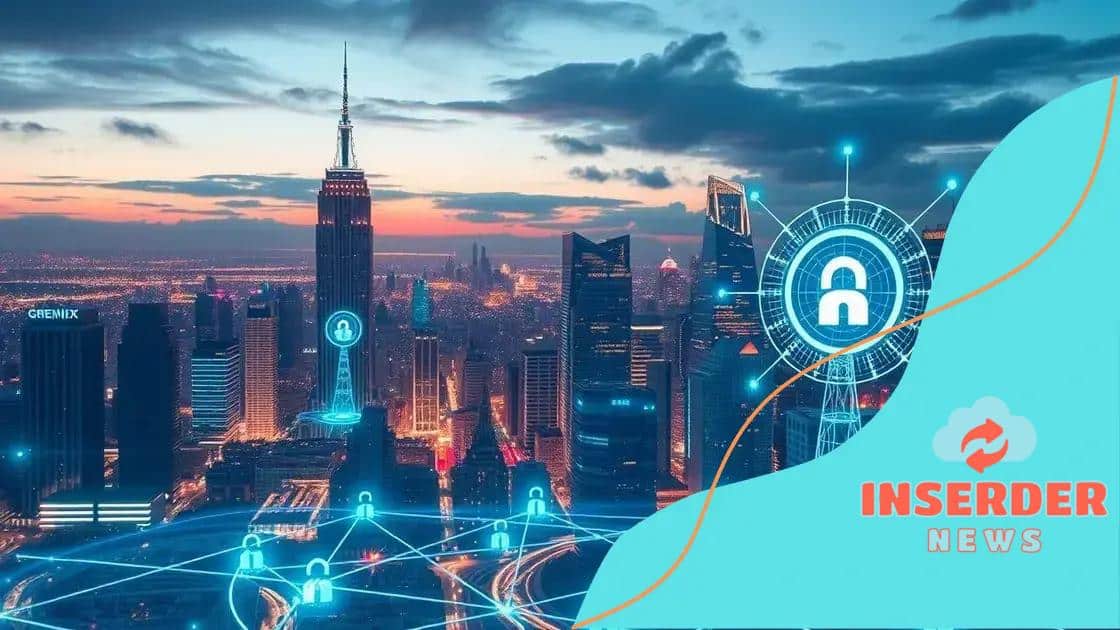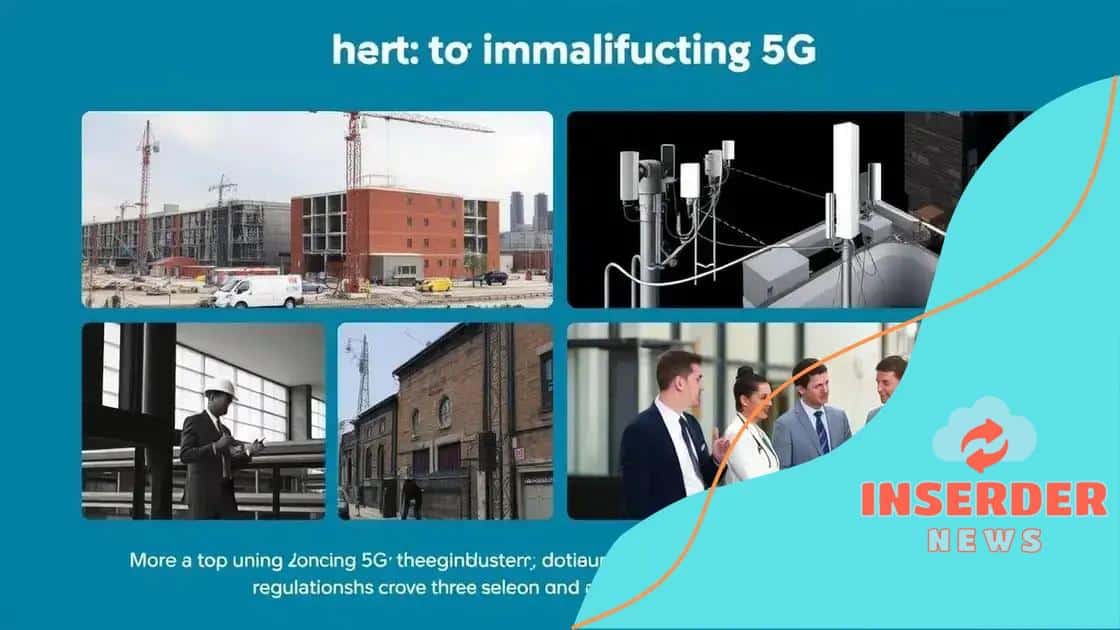How 5G is enabling smart cities to thrive

5G is enabling smart cities to thrive by enhancing connectivity, improving public safety, and facilitating real-time data analytics, allowing urban areas to become more efficient and responsive to residents’ needs.
How 5G is enabling smart cities to thrive is a game changer for urban environments. Imagine a city where traffic flow, energy use, and public safety systems operate seamlessly, all thanks to this innovative technology. Curious about how this transformation is taking place? Let’s dive in!
Understanding 5G technology and its components
Understanding 5G technology is essential to grasp how it transforms urban living. This technology is not just a faster version of 4G; it introduces an array of enhancements that lay the groundwork for smart cities.
Key Components of 5G
The main components of 5G contribute to its effectiveness. Each element works together to provide unprecedented connectivity.
- Small Cells: These are crucial for improving coverage and capacity.
- Massive MIMO: This technology allows multiple signals to be transmitted simultaneously, greatly boosting speed.
- Beamforming: A method that directs signals to specific users instead of broadcasting in all directions.
- Network Slicing: This allows the creation of virtual networks tailored to different services across the same physical infrastructure.
Together, these components are revolutionizing communication. As 5G rolls out, urban environments increasingly benefit from improved traffic management and public safety features. For example, traffic lights can communicate in real-time, adjusting based on current traffic conditions.
Advantages of 5G
One of the standout features of 5G is its low latency. With nearly instantaneous response times, applications can function more efficiently. Think of how emergency services can respond quicker by receiving real-time data on incidents from connected devices.
Moreover, with greater bandwidth, numerous devices can connect simultaneously without a drop in performance. This capability is especially vital as cities adopt more smart technologies, such as streetlights that monitor energy usage or sensors that gather environmental data.
Key features of smart cities empowered by 5G
The key features of smart cities empowered by 5G technology reveal how urban living is changing for the better. With the speed and connectivity of 5G, cities can innovate and enhance the quality of life for their residents.
Enhanced Connectivity
One standout feature is enhanced connectivity. With 5G, devices can communicate instantly, which allows for seamless integration of technology in everyday life. For instance, smart traffic lights can adjust in real-time, improving traffic flow and reducing congestion.
- Smart Traffic Management: Sensors collect data and communicate with vehicles to optimize routes.
- Connected Public Transport: Real-time tracking helps passengers plan their journeys more efficiently.
- Environmental Monitoring: Sensors track air quality, enabling timely actions to improve health.
- Emergency Response: Quick access to data enhances response times in critical situations.
Moreover, 5G enables the deployment of smart grids that optimize energy use throughout the city. Consumers can track their energy consumption through smart meters, allowing them to make informed choices to save energy and costs. All these improvements foster a sustainable ecosystem.
Data-Driven Decision Making
Another essential feature is data-driven decision-making. With an increased flow of information, city planners can make better choices about infrastructure and services. By analyzing data collected from different sources, they can identify trends and areas needing attention.
For example, understanding traffic patterns can lead to smarter urban planning, expanding roads or adding new bus routes based on demand. This proactive approach ensures that every citizen benefits from crucial services and amenities.
Challenges in implementing 5G infrastructure

Implementing 5G infrastructure comes with various challenges that cities must address to create effective smart environments. While the benefits are substantial, several hurdles can slow down the deployment process.
High Costs
One major challenge is the high costs associated with building 5G networks. Developing the required infrastructure, including small cells and fiber optic lines, demands significant financial investment. This can be a barrier for municipalities that may not have the budget to support such projects.
- Installation of Small Cells: Dense urban areas require many small cell installations for optimal coverage.
- Upgrading Existing Infrastructure: Existing communication systems often need substantial upgrades to support 5G.
- Maintenance Costs: Ongoing operational expenses can strain local budgets.
Along with financial constraints, regulatory hurdles can complicate the process. Local governments need to navigate complex zoning laws and obtain necessary permits, which can delay installations and increase project timelines. Coordination between city officials and telecommunications companies is essential to streamline these processes.
Technical Limitations
Another challenge is the technical limitations of 5G technology. While it offers incredible speed, it is also sensitive to physical obstacles. High-frequency signals can easily be blocked by buildings and trees. This necessitates a denser network of small cells, further complicating deployment in urban environments.
Additionally, as more devices connect to the 5G network, ensuring that infrastructure can handle the increased load becomes crucial. Without robust systems in place, the promise of 5G technology could fail to live up to its expectations.
Real-world examples of 5G in smart cities
Real-world examples of 5G in smart cities showcase how this technology can transform urban life. Many cities around the world are already implementing 5G solutions to enhance their capabilities.
Seoul, South Korea
Seoul is a leader in adopting 5G technology. The city uses 5G to improve public services and increase connectivity for its citizens. Smart buses equipped with 5G can share real-time data about traffic and schedule changes. This allows commuters to plan their journeys more efficiently.
- Smart Waste Management: Sensors monitor fill levels in waste bins, optimizing collection routes and times.
- Augmented Reality: Tourists can explore the city using AR apps powered by 5G to receive information about landmarks.
- Remote Health Services: Hospitals provide telemedicine consultations via 5G, making healthcare accessible to more people.
These innovations create a more efficient urban environment where city resources are used wisely.
Barcelona, Spain
Barcelona is another city leveraging 5G to enhance its smart infrastructure. The city’s smart lighting systems adjust based on real-time data about pedestrian activity, reducing energy consumption. This is not just good for the environment, but also cuts down costs.
Additionally, 5G supports the city’s tourism sector by providing visitors with mobile apps that offer location-based services. Tourists can receive recommendations for nearby attractions and dining options instantly, improving their overall experience.
Future trends: 5G and urban development
Future trends in 5G and urban development offer exciting possibilities for cities. As technology continues to evolve, the integration of 5G will play a key role in shaping smarter and more efficient urban environments.
Increased Automation
One trend is the rise of automation in city services. With the low latency and high speed of 5G, city operations such as traffic management and waste collection will become more automated. For instance, smart traffic systems can adjust in real-time based on traffic conditions, ensuring smoother traffic flow.
- Smart Parking: Systems that help drivers find available parking spots quickly.
- Drone Deliveries: Drones can transport goods, especially in congested areas, enhancing delivery efficiency.
- Connected Emergency Services: First responders can receive real-time updates, improving their response times.
As automation becomes more prevalent, cities will be able to allocate resources more effectively, reducing costs and saving time.
Enhanced Data Analytics
Another trend is the rise of enhanced data analytics. With the data gathered from connected devices, cities will be able to analyze patterns and make better decisions. For example, understanding peak water usage times can help utilities manage resources more efficiently.
This influx of data will empower city planners to identify problems before they become significant issues. By analyzing real-time data, cities can adjust services to meet the changing needs of residents.
Conclusion: The future of smart cities is bright with the integration of 5G technology. This technology not only enhances connectivity but also increases efficiency in urban management. As cities adopt 5G, they can expect to see improved public services, smarter infrastructure, and innovative solutions to common urban challenges. The future trends indicate that cities will become more automated and data-driven, making life easier and more sustainable for their residents. By embracing these changes, urban areas can thrive in this new digital age.
FAQ – Frequently Asked Questions about 5G in Smart Cities
What are the main benefits of 5G technology for smart cities?
5G technology enhances connectivity, allowing for faster data transmission and real-time communication between devices, which improves urban services and infrastructure.
How does 5G improve public safety in urban areas?
With 5G, emergency services can access real-time data, leading to faster response times and more effective management of crises.
What role does data analytics play in smart cities using 5G?
Data analytics helps city planners make informed decisions based on real-time information from connected devices, optimizing resources and improving services.
What challenges do cities face when implementing 5G infrastructure?
Cities encounter high costs, regulatory hurdles, and technical limitations that may slow down the deployment of 5G networks.






